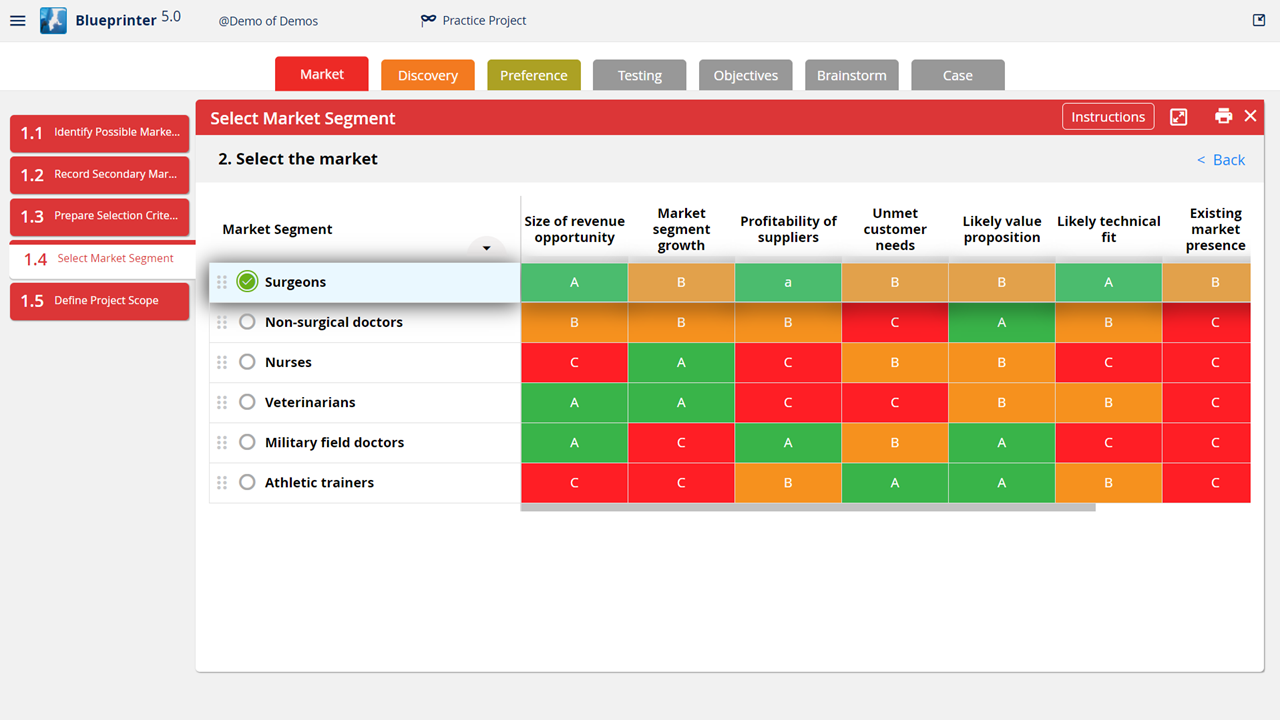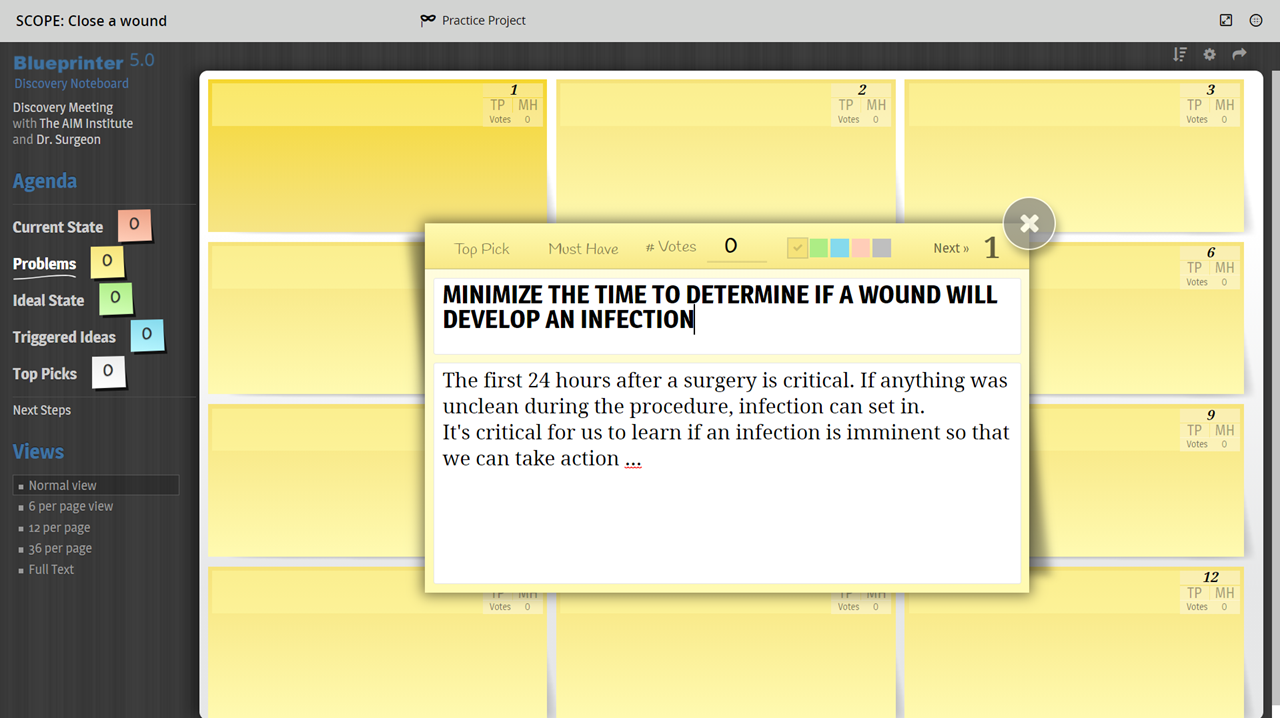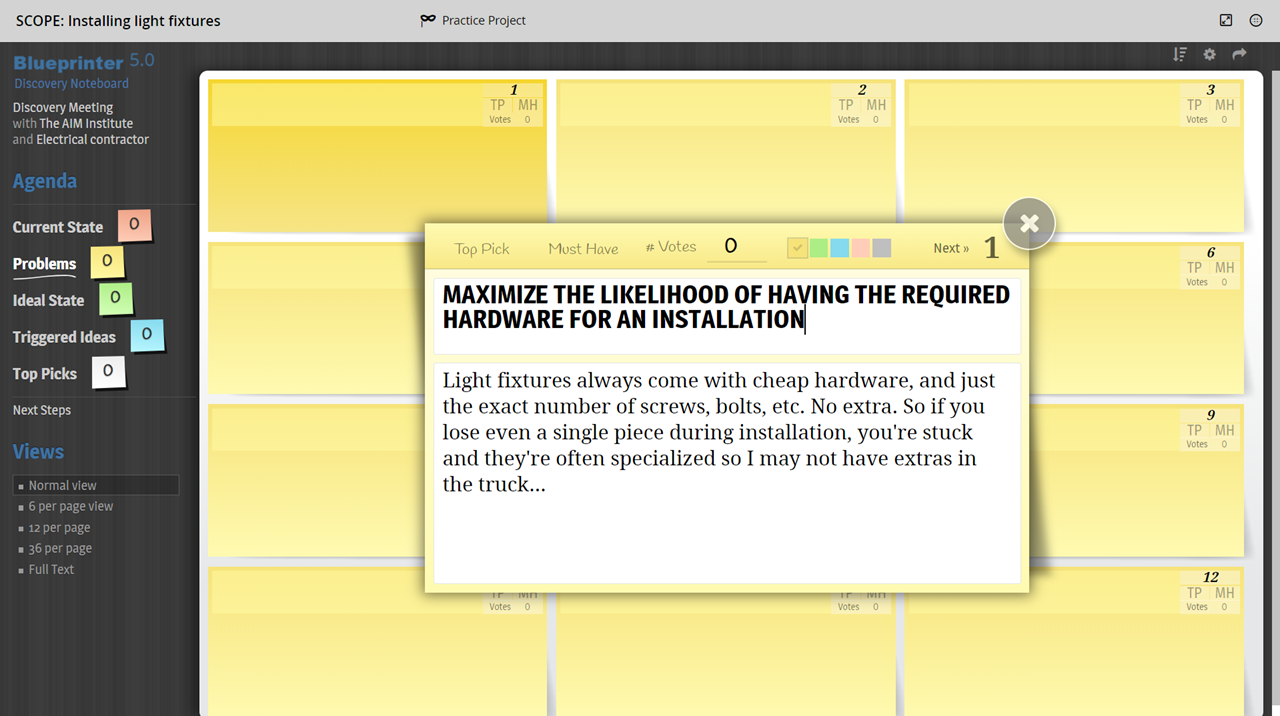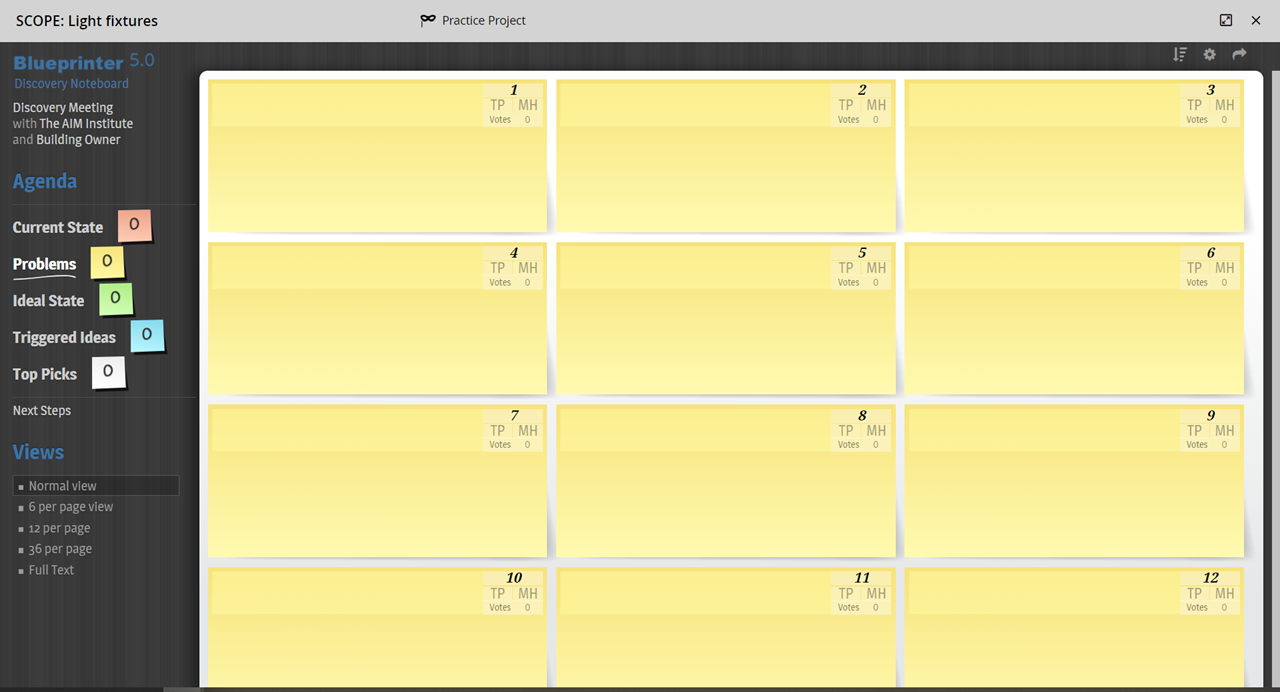To select who to interview: Begin with the JTBD, create a market ecosystem, and then make your selection based upon the fit with capabilities, alignment with strategy, and scope of innovation.
A bit of pre-reading can be helpful for this topic
Before exploring this article, if unfamiliar with “jobs-to-be-done” as a means of framing a market, it’s recommended first to read these articles:
- What is a "Job-to-be-Done?"
- Jobs-to-be-done: The Cure for B2B Myopia
- Disrupt Low Margins with Consumption Jobs
- How to Define Project Scope
How do we select "WHO" to interview?
A customer hires a product to help them to accomplish a job-to-be-done. However, our initial starting point is often a product that we sell (or hope to create). Before we determine who to interview, it’s useful, to begin with, the JTBD, create a market ecosystem, and finally select who to create value for. At a minimum, we’ll want to interview this person to create value for. Still, we may also consider other stakeholders who are either responsible for the results of the job (job overseers) or who may otherwise have influence over the purchase decision.
This article will go through these steps with four scenarios: dog food, sutures, and two involving light fixtures. The dog food example is illustrative and straightforward. The sutures example is a realistic B2B scenario where many stakeholders could be involved. The two examples involving light fixtures represent realistic B2B scenarios, showing how different the customers can be based upon which consumption jobs are targeted. “Consumption” jobs are those jobs that a person executes as they “consume” a product.
EXAMPLE 1: DOG FOOD
This example is meant to be simple, not necessarily reflecting a realistic scenario. Imagine that you make dog food. From there, let’s work through the steps.
-
Begin with the customer’s JTBD
It would be possible to have an extended discussion about the JTBD of dog food. This is the case in nearly all markets. This factor can make it difficult for teams to arrive on a JTBD, and ultimately, on a customer set. But for this example, we’re going to select the consumption job of “Feed the dog.”
2. Create a market ecosystem
We want to identify a set of folks as follows:
- Job executor: Person who executes the job
- Job overseer: Person who does not execute the job, but is responsible for the results of the job
- Job beneficiary: Person who benefits from the execution of the job
- Product Purchaser: Person who purchases the product
- Purchase Influencer: Person who influences the product purchase
Keeping things simple, we’re only going to think about a single household, in which a 10-year-old boy, Junior, is the job executor who has the job of feeding the dog.
The mother of the family, “Mom,” is the job overseer. She doesn’t feed the dog but is responsible for the results. If the dog gets too fat, then she will need to intervene. Mom is also the Product Purchaser and Purchase Influencer. Though these are different roles, it’s common to have the same person in multiple roles, even in real scenarios.
And our Job Beneficiary? Well, that’s the dog, who’s known by his name, “Tuesday.”
3. Select who you want to create value for
So, who do we interview? Perhaps Tuesday? Ok, maybe not! Not only because, well, Tuesday cannot talk, but it turns out that in practice, it’s also rare to select the Job Beneficiary.
It’s either Mom or Junior then as the selection. In practice, it’s usually best to go with the job executor, as they will be the closest to the job of “feed the dog.” What customer needs might there be? Perhaps the dog does, indeed, get too fat. Or maybe the food spills easily when pouring it into the bowl. Maybe it’s difficult to get the last bit of food out of the bag. But it will be Junior, our job executor, who will be most familiar with these is the one we’ll select for this project.
We will aim to create value for Junior, and therefore, he is the customer we’ll interview. The space for the SCOPE in the Discovery Interview will read “Feeding the dog.”
For the rest of the examples, we will not provide further insight as to how each decision was made as to the reason each was chosen. To make this decision, it's useful to consider the fit with capabilities, fit with strategy, and scope of innovation. We elaborate on this further at the end of this article. The "harder work" for most is determining the JTBD and laying out the market ecosystem. Therefore, the rest of the examples will focus on that aspect. Then, at the end, we'll explain more about the criteria for the final customer selections.
EXAMPLE 2: TEXTILES FOR SURGICAL SUTURES
Let’s now look at a more realistic B2B scenario. Imagine that your firm makes textiles, and that one of your customers makes surgical sutures. Who do we interview? Let’s proceed as before.
-
Begin with the customer’s JTBD
We select “close a wound.”
2. Create a market ecosystem
The first job role to identify is the job executor. Who is it that “closes wounds?” We might consider:
- Surgeons
- Non-surgical doctors
- Nurses
- Veterinarians
- Military field doctors
We can use Blueprinter tool 1.4 to help guide this decision.

After some deliberation, we go with Surgeons as our job executors. We fill out the rest of the ecosystems as follows:
- Job overseer: Hospital executives, Physician supervisors
- Job Beneficiary: Patients
- Product Purchaser: Procurement folks
- Purchase Influencer: Nurses
3. Select who you want to create value for
We’ll select the job executor, the surgeon, as our target. In Blueprinter, the Discovery Noteboard would appear like this:

EXAMPLE 3A: COMMERCIAL LIGHT FIXTURES #1
Let’s consider another B2B example. Imagine that you make commercial light fixtures. In this case, it’s helpful to explore the consumption jobs for consuming light fixtures. Here’s a potential list:
- Select the light fixtures
- Purchase the light fixtures
- Pay for the light fixtures
- Get the light fixtures delivered
- Return the light fixtures
- Install the light fixtures
- Learn to use the light fixtures
- Use the light fixtures
- Obtain support for the light fixtures
- Repair the light fixtures
- Upgrade the light fixtures
- Dispose of the light fixtures
- Once again… we begin:
-
Begin with the customer’s JTBD
Looking over the list of consumption jobs, we might select any of these. But we will go with “Install the light fixtures.”
2. Create a market ecosystem
Who installs light fixtures? Electrical contractors. They will be the job executors.
And the others:
- Job overseer: General contractors
- Job Beneficiary: Commercial building owners, Patrons of the business who’ll use the lights
- Product Purchaser: Contractor purchasing representative
- Purchase Influencer: Architects
3. Select who you want to create value for
Who should we pick? Once again, we go with the job executor. The electrical contractors will be the most knowledgeable about issues when installing light fixtures. Note the image below as to how this might appear in Blueprinter:

How might this have played out differently if we’d chosen different consumption jobs? Let’s see for the next and final scenario.
EXAMPLE 3B: COMMERCIAL LIGHTING FIXTURES #2
-
Begin with the customer’s JTBD
This time, from the subset in Example 3A, we’ll target a different set of jobs as follows:
- Select the light fixtures
- Pay for the light fixtures
- Use the light fixtures
- Repair the light fixtures
- Upgrade the light fixtures
2. Create a market ecosystem
We’ll begin with the job executors:
- Select the light fixtures => Architect, Building owner
- Pay for the light fixtures => Building owner
- Use the light fixtures => Building owner
- Repair the light fixtures => Building maintenance personnel
- Upgrade the light fixtures => Building maintenance personnel
While we could list the rest of the ecosystem (job overseer, etc.), we’ll leave that bit out for the sake of discussion.
3. Select who you want to create value forIn this case, we have three audiences:
- Architects
- Building owner
- Building maintenance personnel
We could narrow our project and select just one, but we’ll go with all three.
So, how will this appear in Blueprinter? Like so:

In this case, we just list the product as the scope. During the interview, we can ask, “What problems do you have with your light fixtures?” But of course, we’ll want to keep the conversation focused around our chosen consumption jobs: Select, Pay for, Use, Repair, and Upgrade the light fixtures. How can we represent this in Blueprinter? With a Trigger Map, as follows:

In fact, in a scenario like this, it often is preferred to begin with the Triggered Ideas so that you can clarify the specific jobs of interest.
Once we’ve described the markets, how do we know which to select?
In each of the scenarios above, we described the process of determining a market, in the form of a JTBD and a job executor, that could be targeted for innovation with a New Product Blueprinting project. However, conveniently enough, it didn’t mention why each was selected. Why did we select surgeons instead of veterinarians? Why electrical contractors instead of building owners?
The market itself you choose should be winnable and worth winning. Blueprinter tool 1.4 helps facilitate this decision. However, within that market, when choosing amongst the “worth winning” candidates within the defined market ecosystem, at least three variables should strongly impact the decision:
- Fit with capabilities
- Alignment with strategy
- Innovation scope
Fit with capabilities
For this, you might protest, “But we don’t know what our ultimate product will be yet?” However, in practice, I’d argue that, more often than not, you do have a pretty good idea of the product category in the least. When measuring the market participants against their fit with your capabilities, here are some questions that may be helpful:
- Is it a job that we’re serving today?
- Could current or planned products address a need there?
- Do we have technology that could help in this market?
- Is this a fit with our distribution? Our brand?
- Do we have access to these customers now?
Alignment with strategy
Everything your team does should be aligned with the corporate strategy. Here are some questions to ask to make this assessment:
- Is this a targeted market within the strategic plan?
- Is this market within a targeted vertical industry?
- Does the current leadership have enthusiasm for pursuing this market?
Innovation Scope
As a Blueprinting team approaches a new project, there can be tension between how much this insight could help near-term sales, and how much it could inform future development. As a rule of thumb, the more near-term the goals are, the more it makes sense to scope a project around a current product type and the associated consumption jobs. And the more the goals are longer-term, and strategic, the more it should be focused around the core job.
For example, it makes perfect sense to frame a project around electrical contractors who want to install light fixtures for a near-term scope. But if you make light fixtures, you might go to the core JTBD of light fixtures as a longer-term play, which could be, “Maintain indoor lighting.” This JTBD presents a more strategic objective because, in a future world, commercial buildings could conceivably “maintain indoor lighting” without lighting fixtures at all. Perhaps a new technology could eliminate the product category altogether.
